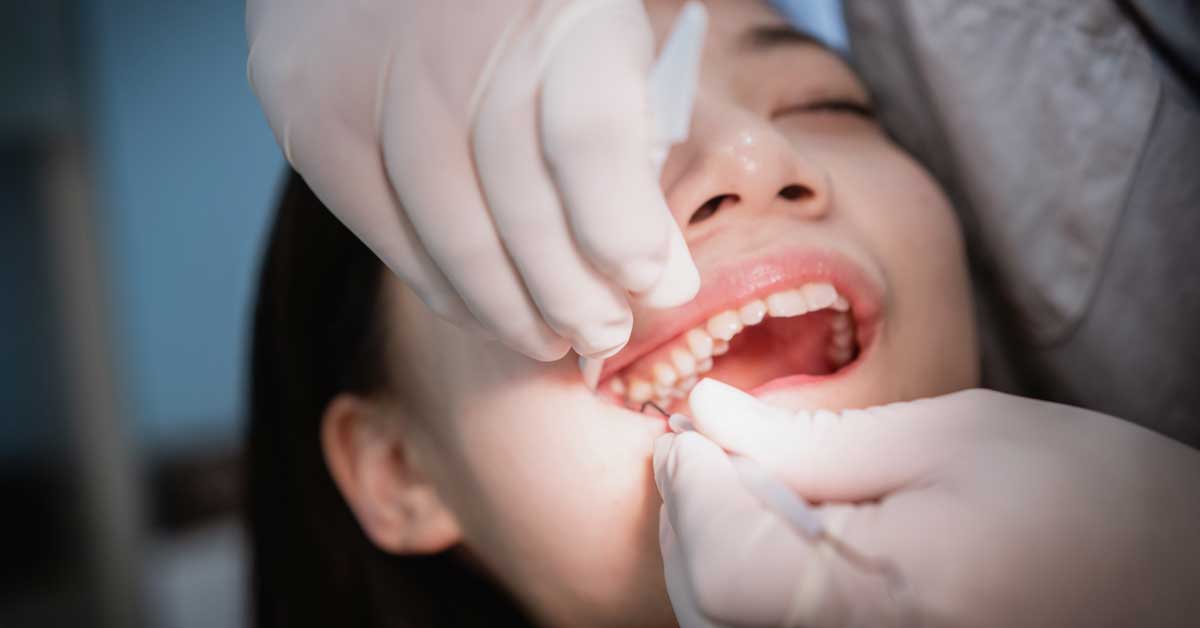Can you Reverse Gum Disease?
Are you experiencing bleeding, swollen gums, or bad breath? If so, you may be suffering from gum disease. This common condition affects millions of people worldwide and if left untreated, can lead to tooth loss.
But is it possible to reverse the damage caused by gum disease and restore your oral health once again? In this article, we will discuss what causes gum disease, its symptoms, and most importantly, whether or not it can truly be reversed.
What is Gum Disease?
Gum disease, also known as periodontal disease, is a common condition that affects the tissues supporting your teeth. It starts with bacteria in your mouth forming a sticky film called plaque on your teeth. If you don’t brush or floss properly, this plaque can harden into tartar that brushing doesn’t clean.
The early stage of gum disease is called gingivitis. You might notice your gums are red, swollen, and bleed a little when you brush or floss. If left untreated, gingivitis can turn into periodontitis. That means the inflammation has spread deeper, affecting the bone and tissues that hold your teeth in place.
It’s important to catch gum disease early. You can do this by maintaining a good oral hygiene routine which includes brushing twice a day, flossing daily, and seeing your dentist regularly.
Can You Reverse Gum Disease with Proper Maintenance?
Yes, it is possible to reverse gum disease, but it depends on the stage of the disease. The first stage of gum disease, known as gingivitis, can be reversed with proper treatment and oral hygiene practices. such as brushing, flossing, and regular dental cleanings
The First Stage is Reversible
Gingivitis is the first stage of gum disease, but it’s important to know that it’s also reversible with proper care. You might notice that your gums are red, swollen, and bleed easily common signs you should not ignore. This condition results from plaque buildup on your teeth, which can be countered with good oral hygiene practices.
The Second (Advanced) Stage is Non-Reversible
Periodontitis is a gum disease that you want to avoid. Think of it as a silent alarm for your oral health. When you’ve reached this second stage, it means the infection has gone beyond your gums. It’s now affecting the bones that support your teeth. Sorry to break it to you, but this damage can’t be reversed. You’ll notice your gums pulling away from your teeth, creating spaces that can get infected. This is serious because your body’s immune system fights the infection, but it also breaks down the bone and connective tissue that hold your teeth in place.
How Can You Reverse Gum Disease?
Practice Good Oral Hygiene
Practicing good oral hygiene is the cornerstone of preventing and reversing gum disease. By maintaining a diligent brushing and flossing routine, you are actively removing the plaque that can lead to gingivitis, the earliest stage of gum disease. It is recommended that you brush your teeth at least twice a day with fluoride toothpaste and floss daily to clean the spaces your toothbrush can’t reach.
Visit Your Dentist Regularly
Regular visits to your dentist are vital in maintaining not just your smile, but your overall health. If you’re experiencing early signs of gum disease, such as redness, swelling, or bleeding gums, know that catching these symptoms early on can lead to a complete reversal of the condition.
Your dentist plays a crucial role in this process by performing professional cleanings to remove plaque and tartar buildup.
Moreover, during your check-up, your dentist will educate you on proper oral hygiene techniques and may suggest lifestyle changes or products to support your gum health. They can also detect signs of gum disease that you might not notice on your own.
Quit Smoking
When you decide to quit smoking, you are not only taking a step towards better lung health, but you are also significantly aiding your oral well-being. Smoking cessation has a remarkable impact on your gums. It stops the progression of gum disease and promotes healing within your mouth.
As smoking is a major risk factor for gum disease due to its interference with the normal function of gum tissue cells, giving up this habit allows your gums to receive the necessary oxygen and nutrients from your bloodstream to recover from damage.
You’ll notice a decrease in gum inflammation and bleeding as the toxic effects of smoke subside. Moreover, quitting smoking improves your immune response, making your body more effective at fighting off gum infections.
Early Diagnosis is the Key
Recognizing the early signs of gum disease is your best chance to avoid long-term consequences and possibly reverse the condition. In its initial stage, known as gingivitis, you might notice redness, swelling, or bleeding while brushing or flossing.
You mustn’t ignore these warning signs. Taking action at this stage can prevent progression to more serious periodontitis, which can lead to tooth loss and affect overall health.
Should you notice any signs of gum trouble, act swiftly. Early intervention can halt the damage and potentially heal your gums, enabling you to maintain a healthy, confident smile.
Laser Periodontal Therapy
If you’re battling gum disease, Laser Periodontal Therapy (LPT) may be the breakthrough you need for a healthier smile. Through LPT, a highly focused laser light targets and removes infected gum tissue while preserving healthy areas. This precision treatment eliminates harmful bacteria and helps in reducing periodontal pockets.
With LPT, you can expect less discomfort, quicker healing times, and often, the regeneration of tissue and bone lost to gum disease. Embrace advanced dental care with LPT to rejuvenate your gums and protect the foundation of your teeth.
Surgery
When facing advanced periodontal disease, you may require surgical treatments to preserve your oral health. Flap surgery, for example, involves lifting the gums to remove tartar deposits in deep pockets. The procedure aims to reduce the pocket size and enhance the ability to maintain cleanliness.
Bone grafting, in instances where the bone supporting your teeth has been destroyed, involves the use of fragments of your bone, synthetic bone, or donated bone to replace and regenerate lost bone.
This can help restore the stability of your teeth. Similarly, bone regeneration is a technique that employs biocompatible membranes, often in conjunction with bone grafts, to encourage your body’s natural ability to regenerate bone and tissue. Understanding these procedures can empower you to make informed decisions about your dental care and contribute to a successful outcome.
Conclusion
Gum disease is a common oral health issue that affects millions of people worldwide. While the thought of having irreversible damage to your gums can be daunting, the good news is that gum disease can be reversed in its early stages through proper oral hygiene, regular dental visits, and quitting smoking.
However, once it progresses to its advanced stage, it becomes non-reversible and may require more intensive treatments such as laser therapy or surgery. The key is to catch and treat the disease early on with early diagnosis being crucial. So make sure to take care of your oral health by practicing good oral hygiene habits, visiting your dentist regularly, and seeking treatment at the first sign of gum disease.
Frequently Asked Questions
Symptoms of gum disease range from mild in gingivitis to severe in periodontitis. Early signs include swollen, bleeding gums, bad breath, and a bad taste in the mouth. Advanced symptoms involve loose teeth, gum abscesses, receding gums, changes in bite, tender or discolored gums, persistent bad breath, and pus between teeth and gums. Prompt dental care is crucial to halt the progression of gum disease.
Gum disease is diagnosed through a dental exam involving a review of your medical history, examination of your gums for inflammation, checking for loose teeth, measuring the depth of pockets around your teeth with a probe, and dental X-rays to detect bone loss. Dentists assess these factors to identify the presence and stage of gum disease, guiding appropriate treatment plans.
Gum disease progresses through three main stages: 1) Gingivitis, the initial stage, where gums become red, swollen, and may bleed easily due to plaque build-up. 2) Periodontitis, where untreated gingivitis advances, causing gums to pull away from teeth, forming pockets susceptible to infection. 3) Advanced Periodontitis, the final stage, where the bones and fibers supporting the teeth are destroyed, leading to tooth movement or loss if not treated promptly.
Gingivitis, the early stage of gum disease, is characterized by red, swollen gums that may bleed easily, caused by plaque accumulation. It’s reversible with good oral hygiene. Periodontitis follows untreated gingivitis, leading to irreversible damage to the soft tissue and bone that support teeth, forming pockets, receding gums, and potentially resulting in tooth loss. Prompt treatment can manage periodontitis symptoms and prevent further damage.
Gum disease can be prevented with regular dental hygiene practices: Brushing teeth twice daily using fluoride toothpaste, flossing daily to remove plaque between teeth, regular dental check-ups for professional cleaning, and quitting smoking. A balanced diet low in sugar also supports oral health. These steps reduce plaque build-up, preventing gum disease onset and progression.
Cosmetic and General Dentistry In Miami, FL
Take the first step towards the smile of your dreams by booking a consultation with our experts in cosmetic and general dentistry.



